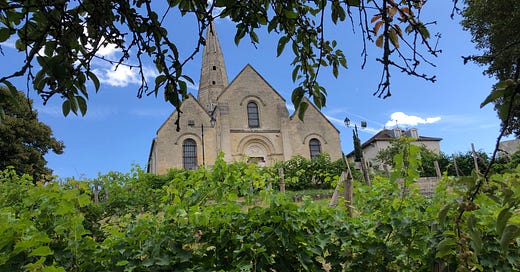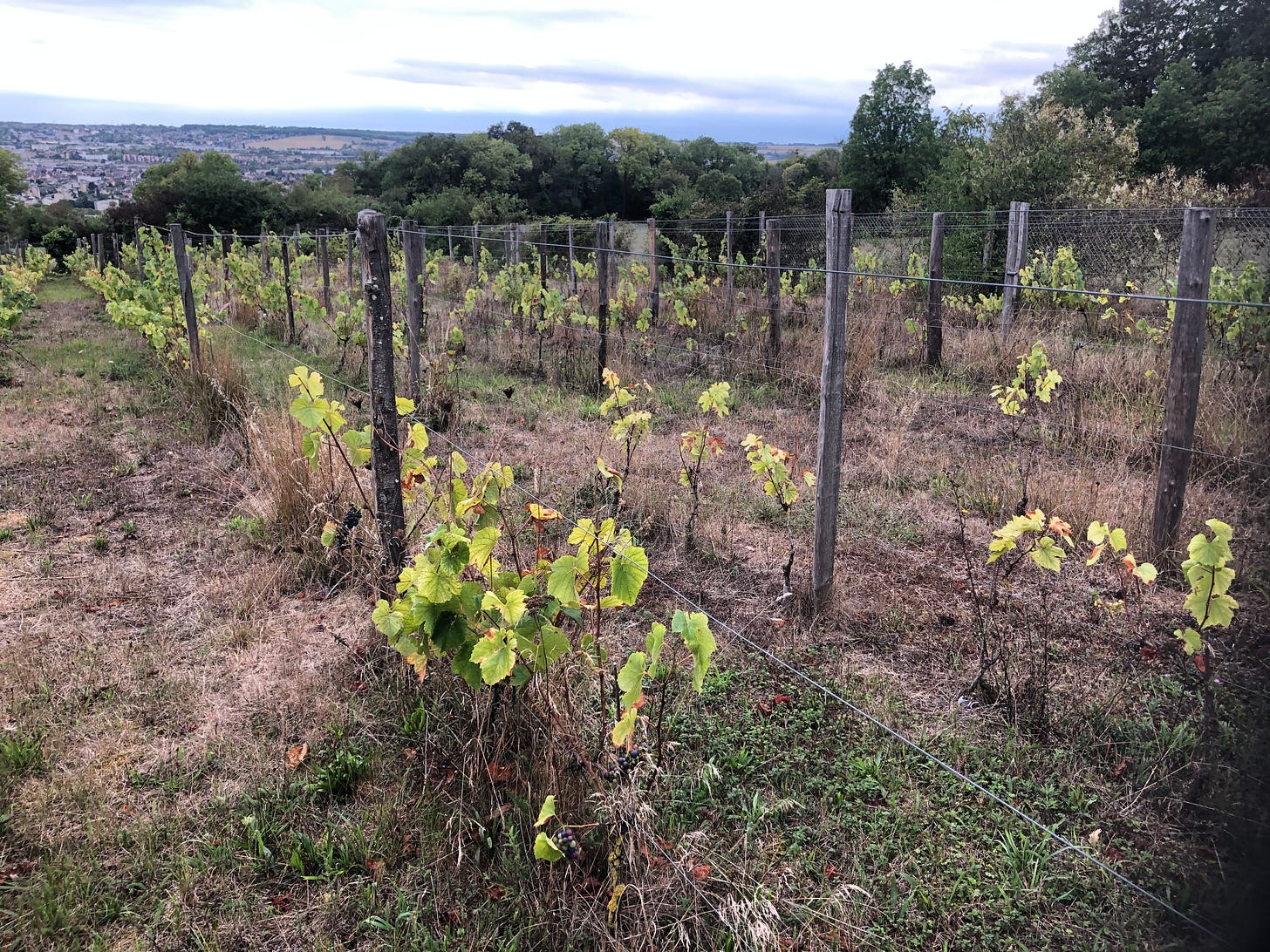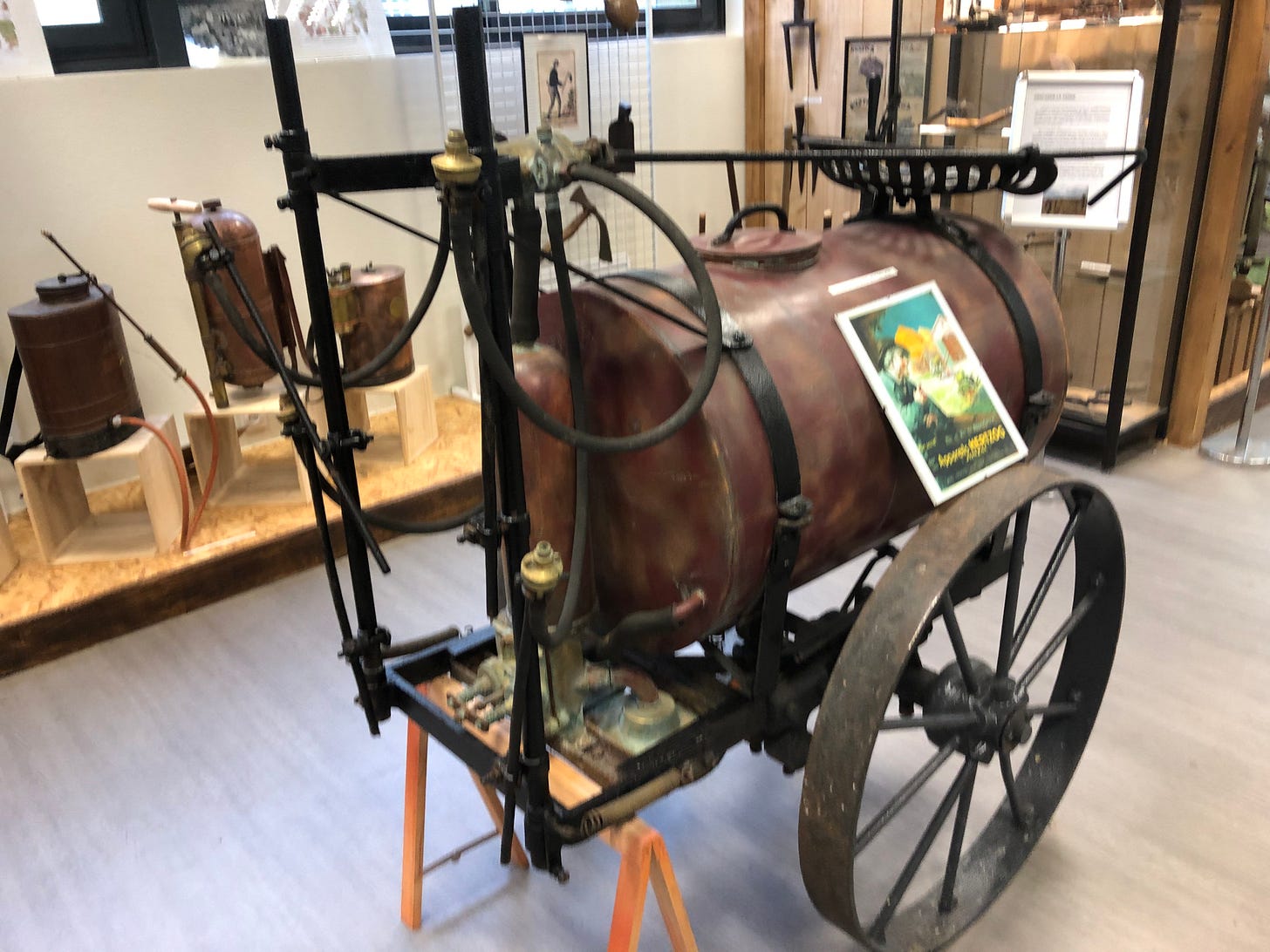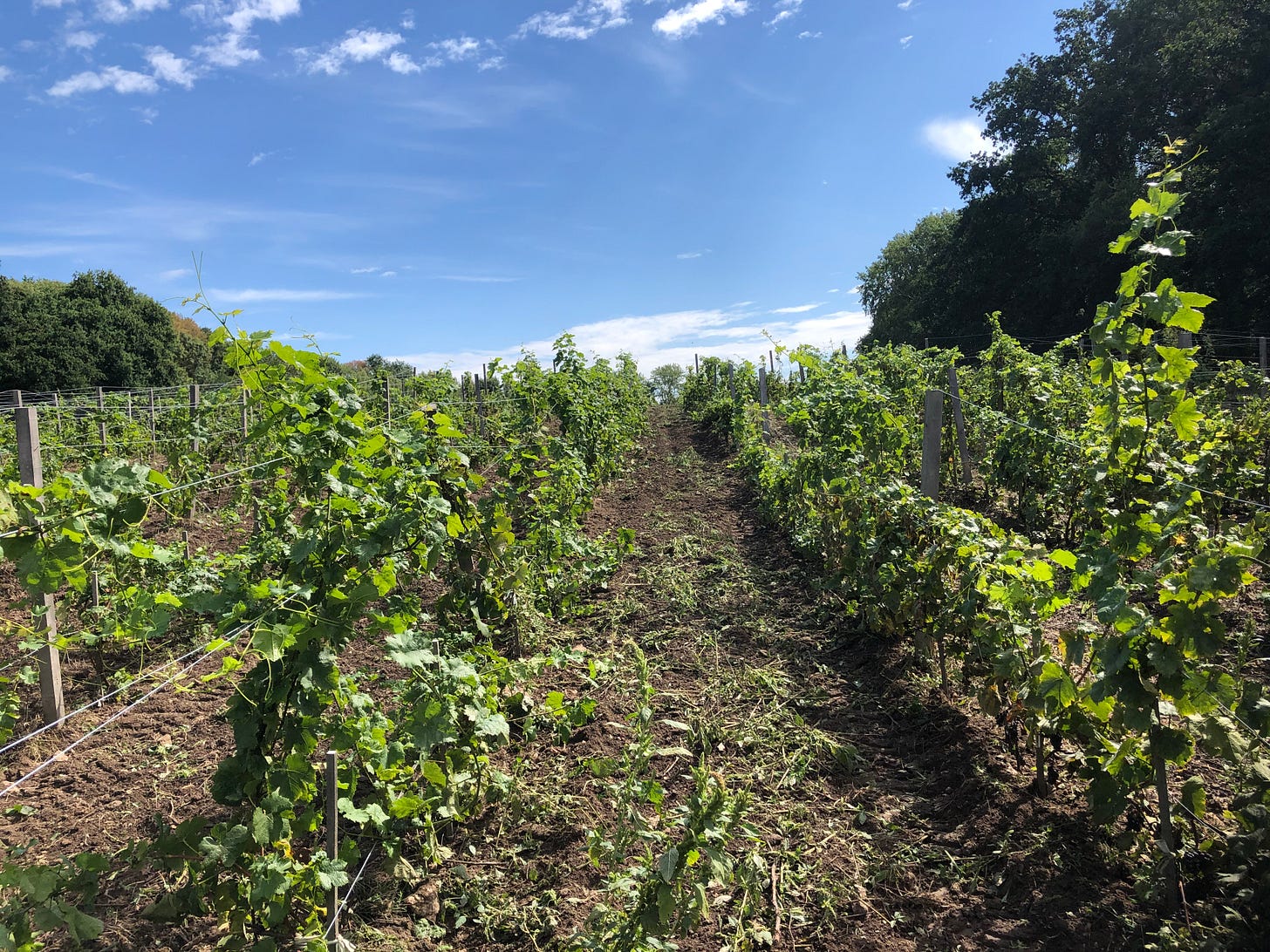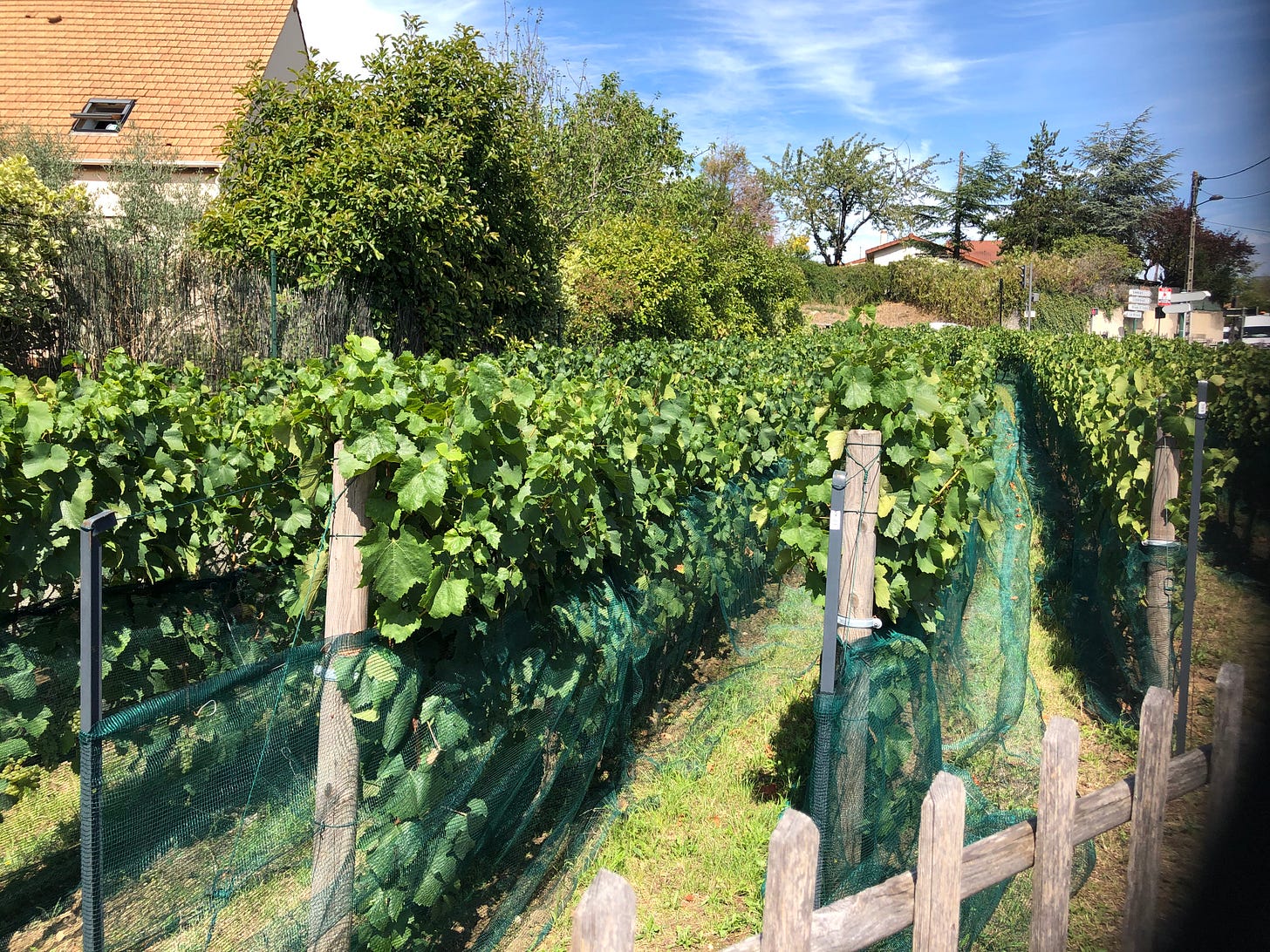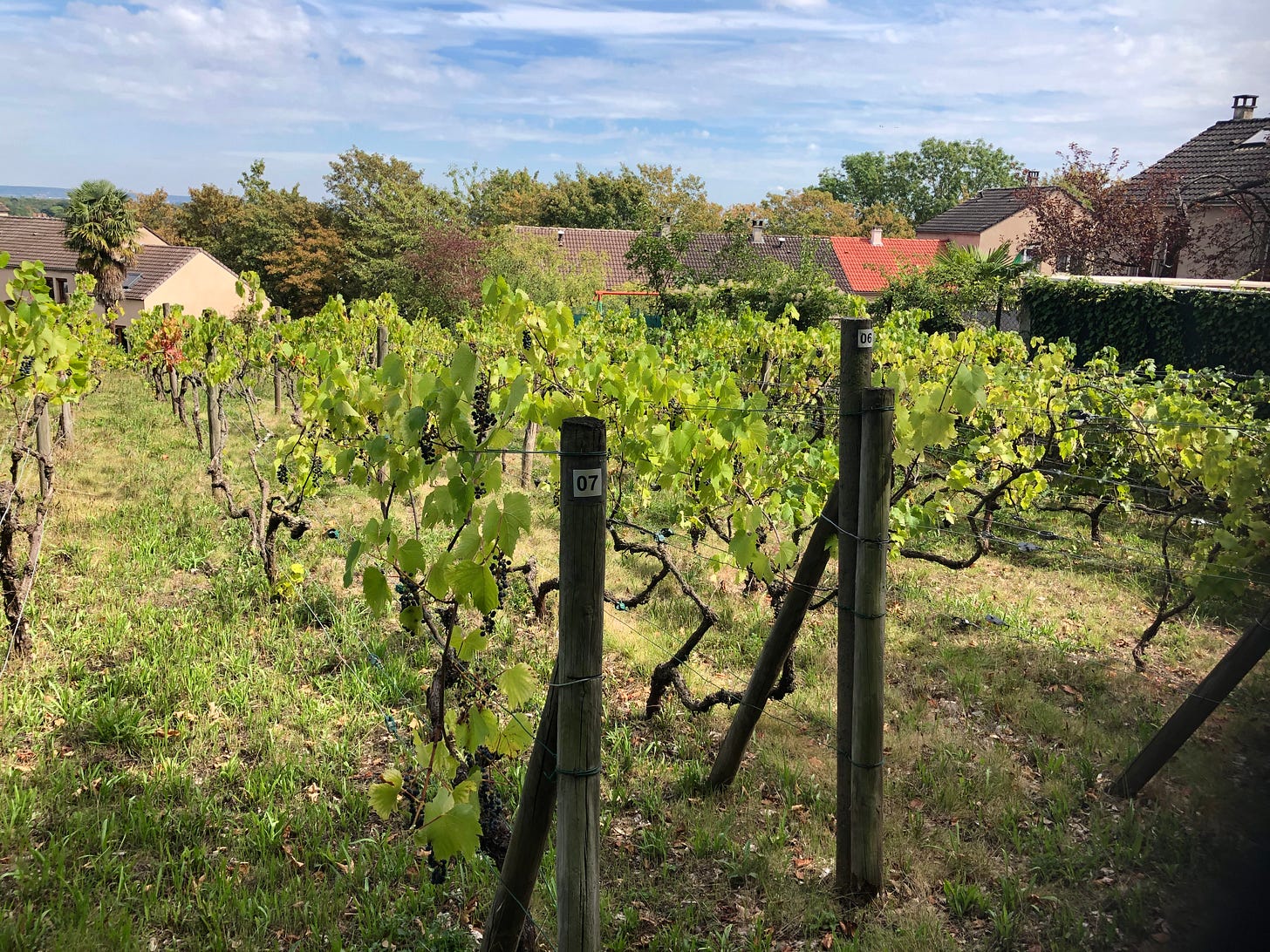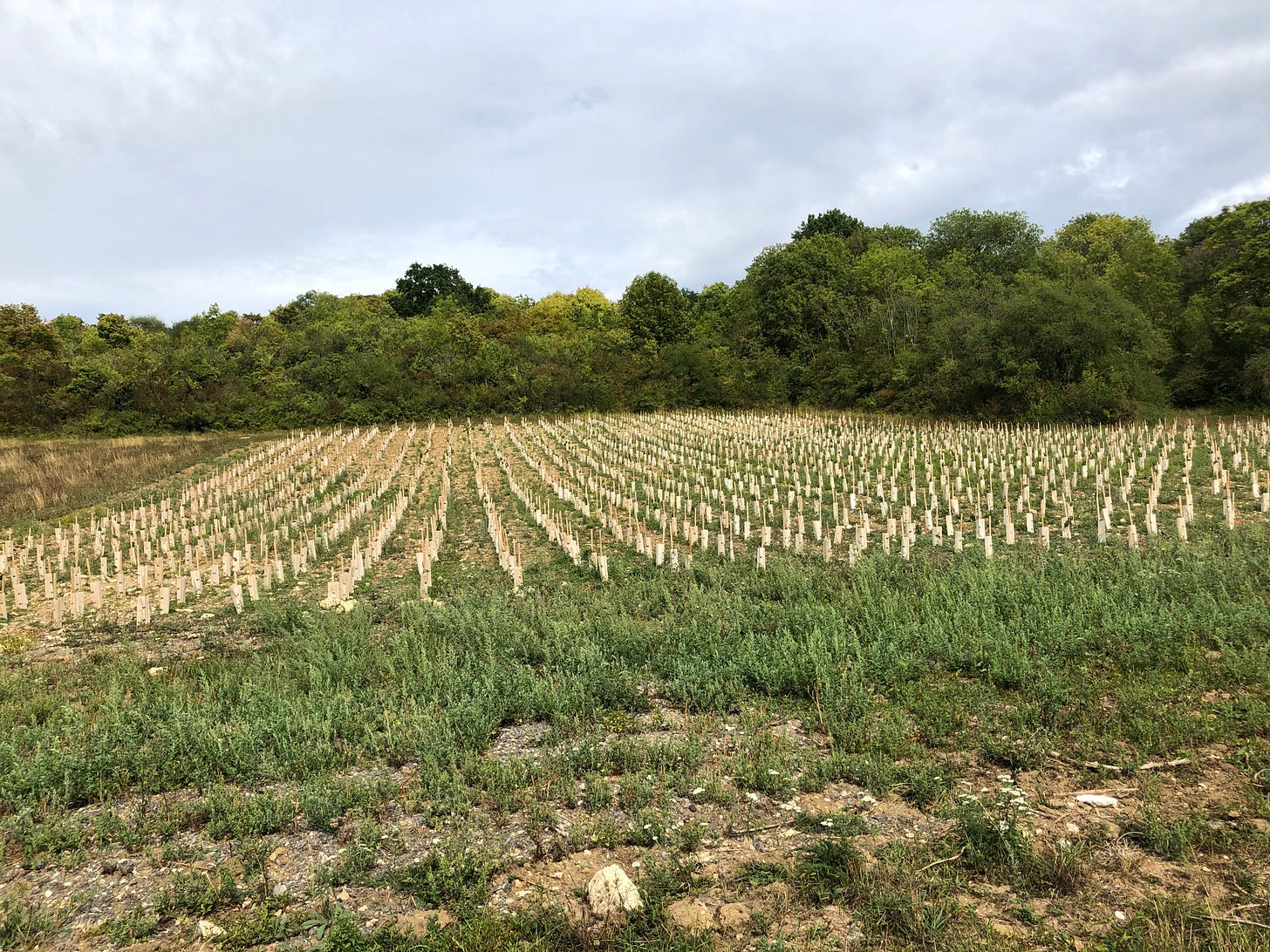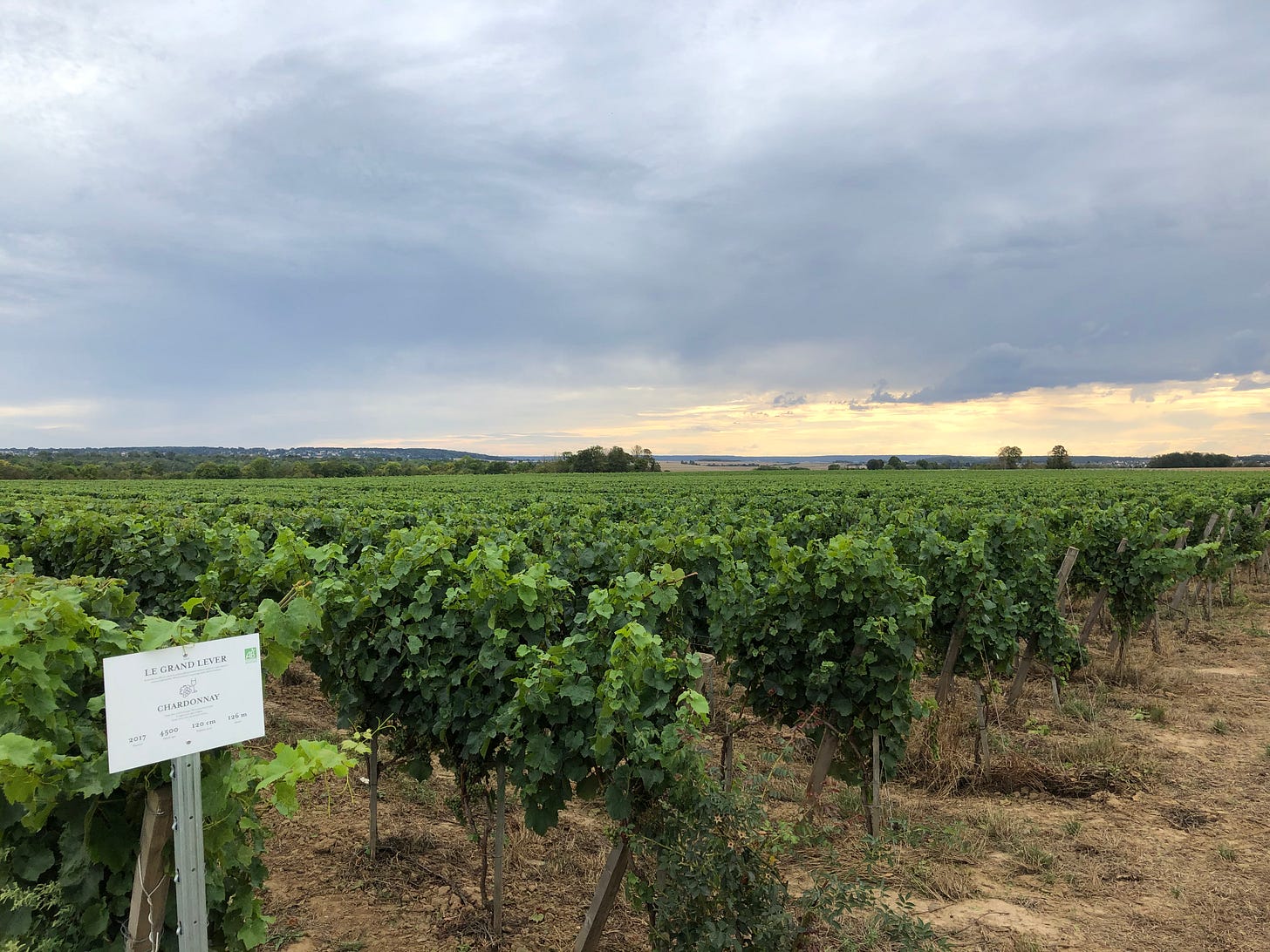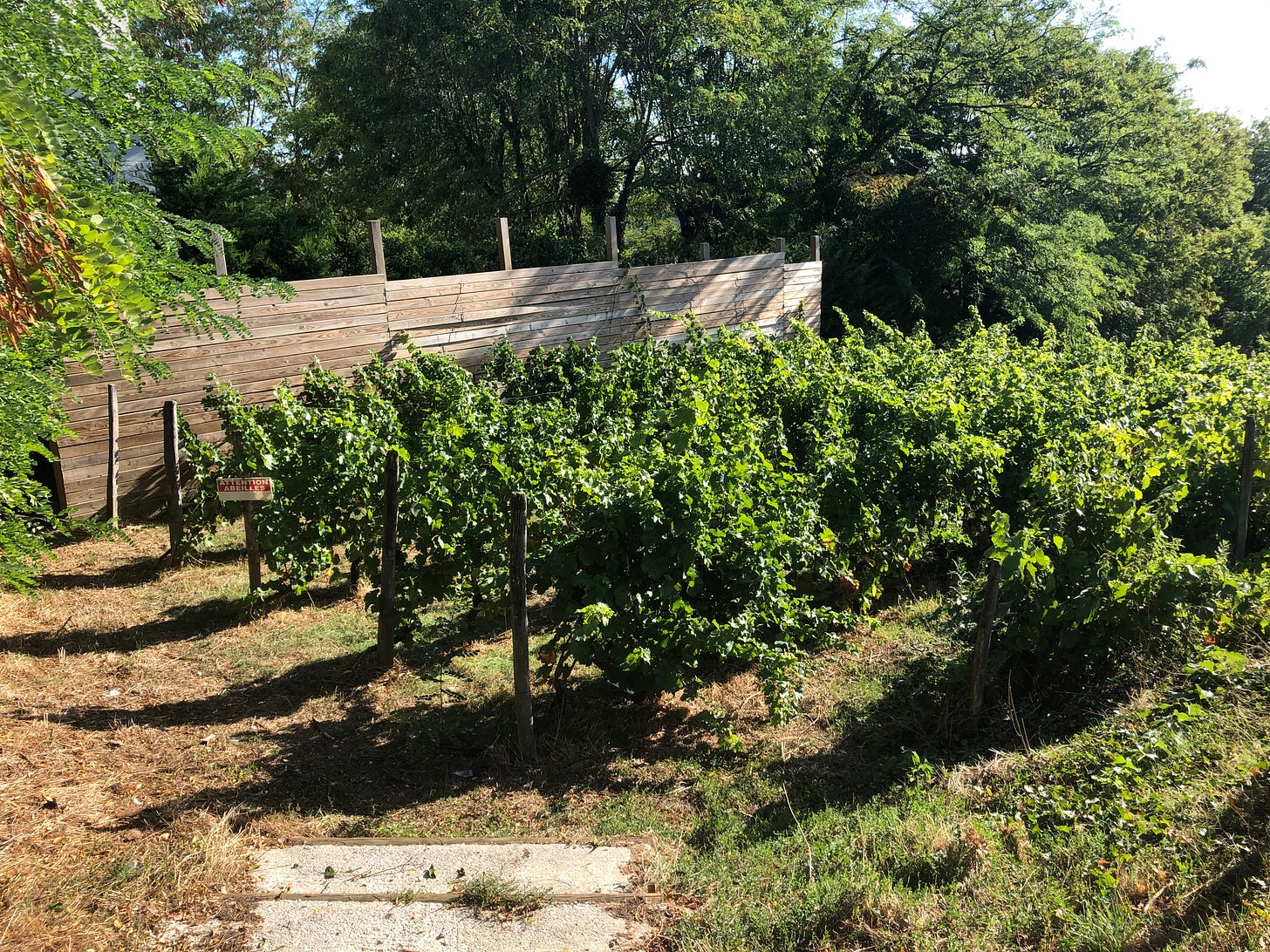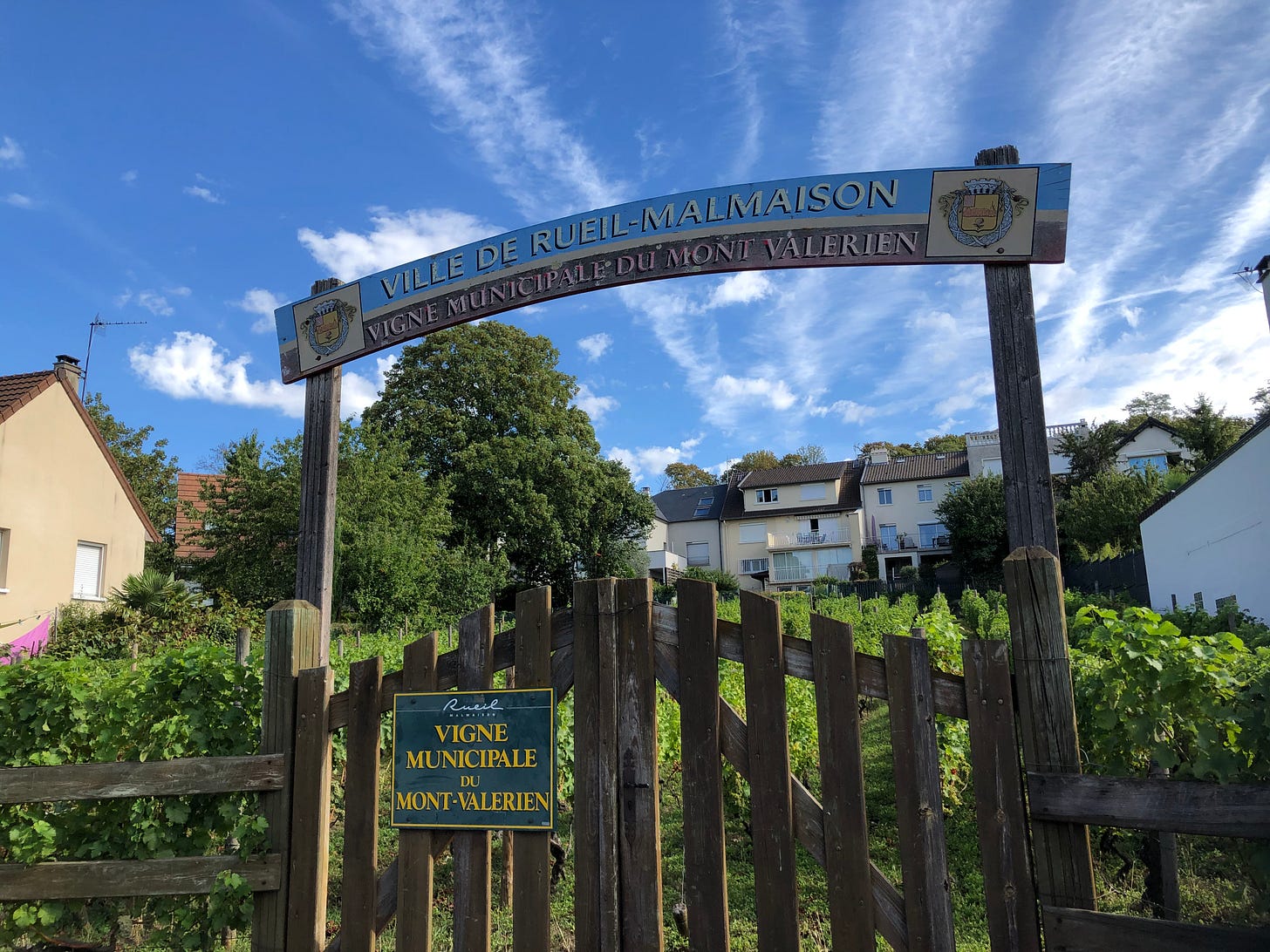During the summer of 2020 I went on a vineyard seeking expedition around the Île de France, and managed to locate over sixty of the 140 vineyards I was given to understand are out there. If you’re coming to this for the first time, the Île de France (IDF for short) is the region around Paris, which was, up until about two-hundred years ago, the biggest and most revered wine region in the world.
There were thousands of vineyards in the Île-de-France. Paris alone was surrounded by vineyards, with some estimates suggesting that the city had around 30,000 to 40,000 hectares (approximately 74,000 to 99,000 acres) of vineyards during its peak wine production period prior to the 18th century.
The vineyards were divided into numerous small parcels. In this context, a parcel refers to a distinct plot of land dedicated to vine cultivation, which could be as small as a few hundred square meters. The fragmentation of land ownership and cultivation was typical, meaning that these thousands of hectares were subdivided into tens of thousands of smaller parcels. It was not uncommon for individual vineyards to consist of numerous small, scattered parcels.
The vineyards were not only extensive, they also produced wines that were considered among the best in the world, other regions of France struggling to compete. But the decline was dramatic, relegating the IDF to the annals of history and today, despite the zealous renaissance underway, almost forgotten.
This is the first part of a series on the municipal, associative, and heritage vineyards that I visited in 2020, which also includes some of the commercial vineyards I visited at the time. They are listed in the order by which I visited them, and so are not alphabetical.
Mantes-La-Jolie - Chai du Clos des Vieilles Murailles; 1 quai de la Vaucouleurs 78200 Mantes-la-Jolie. The association is a wine-loving fraternity whose aim is to create, promote, develop and support wine and winemaking in Mantes-la-Jolie (Yvelines) in a friendly and sharing spirit.
Follainville-Dennemont - 19 Rue du Bois 78520 Follainville-Dennemont - Patrick Brico, president of the association of the communal vines of Follainville showed me the vineyard planted to Pinot Noir with varietals that he claims are not resistant to calcium, so the vineyard has suffered. Looks rather sad. Beautiful press in the caves of the former Château de Condorcet. Chai also in the château caves, but too cold for vinification. Excellent tomatoes.
Marines - La Maison des Arts et Métiers de la vigne. With two hundred vines already planted in Les Hautiers, the municipality of Marines wanted to create a Maison des Arts et Métiers de la Vigne (House of Vineyard Arts and Crafts). As one might imagine, this is a treasure trove of antiquated vineyard tools that capture the spirit of the hands-on viticultural labour of the past.
Le Clos Ferout - Purchased by Bruno and Claire Lafont in 2010, comprising numerous buildings in ruins and an uncultivated estate. Buildings were restored in 2011-2012 along with surrounding walls and the environment: creation of hedges, orchards and paddocks for horses, and restoration of biodiversity. Planting authorisation was granted by Agrimer inn 2016, following new European regulations. Soil analysis and preparation of the land. 2017: Planting of the first Pinot Noir vines on 1 hectare of the Clos Ferout estate. 2021: Planting of 1,500 Pinot Noir vines and 2,000 Pineau d'Aunis vines – total vineyard area 1.5 hectares. The Clos Ferout now belongs to the Spher family of Pif à Papa.
Montgeroult - The vines here are along a road as you come into town, but I stupidly missed taking pictures of them, heading to an address where no one was home. There is also a 'decorative' 'symbolic' collection of vines near the church that I did photograph.
Vigne d'Osny - At the corner of Rue de Montgeroult and Route d'Ennery, 95520 Osny (in the middle of a rather non-descript suburb), the association Les Amis de Grouchy cultivates a vineyard of 269 Chardonnay vines, planted in 2011.
Jouy-le-Moutier/Pontoise - Five hundred Baco Noir vines climb the hillside on Rue des Vignes Blanches in Jouy-le-Moutier (access between 10 and 12 Rue des Vignes Blanches, or up Rue des Cépages on the left at the top). This vineyard, originally planted in 1905, belongs to the municipality, and is managed by the association ‘Le Coteau des Jouannes’. Twenty families share the maintenance of the rows and participate in the winemaking process.
Chanteloup les Vignes - Planted in 2008 by the Avic Association, the vines of the Chanteloup vineyard produced two recent vintages that were deemed ‘quite satisfactory’ at the winegrowers' festival. The municipality, led by Pierre Cardo, had committed in the 2000s to planting new vines. Today, 2,600 m² of land and 773 vines are managed by Avic along the Chemin de la Croix de Saint-Marc, using the current grape varieties. ‘Mainly Chardonnay (white) and Pinot Noir (red),’ says Michel Barbier.
Nézel - I didn't speak with anyone here but took photos of the very recently planted vines. The setting is sub-urban with the vines overlooking a road of little houses, but backed by woods.
Beynes - The Coteaux de Beynes vineyard covers 1,000 square metres and has 530 Chardonnay vines. All operations, right down to sticking the labels on the glass bottles with milk, are carried out in the corridors of a ruined fortified castle dating from 1073. This medieval fortress once belonged to François I and was inhabited by Diane de Poitiers. ‘This allows us, as in Bordeaux, to state on the label that the wine was bottled at the château,’ says Jean-Pierre Kezrven, president of the association, with a smile. The vineyard is an idyllic setting on a hillside overlooking the valley and the town with a small house that serves for the association meetings and festivities. I first visited in the summer of 2020 and returned for the harvest that same year.
La Bouche du Roi – This vineyard in Davron on the ‘plain of Versailles’ is impressive for its size as it is by far the largest vineyard in the Ile de France and so currently the biggest commercial producer. Planted to Chardonnay, Chenin, Merlot, Pinot Noir, it extends over 20 hectares with recent plantings of additional Chardonnay.
Suresnes – This first visit did not allow me access as there was no one present. I have since participated in two harvests and been there several times. Easy access by tram from Porte de Versailles to Suresnes Longchamp. The walk up to the vineyard is about 10 minutes or 2 minutes by bus.
Rueil Buzenval Vignoble - vines in the centre of the suburb. Jumped the fence to take pictures. Rueil: The first vineyard is located on the slopes of Mont-Valérien. Here, replacing an abandoned vineyard, 750 Sauvignon vines were planted on 1,150 square metres of south-west facing clay-limestone soil. The second vineyard is located in the Buzenval district with 150 Sauvignon vines spread over 400 square metres facing east-west.
Louveciennes – The vines are located below the aqueduct of Louveciennes. Pretty setting and perhaps a nice place for a picnic. Vineyard is accessible from the top right corner when the aqueduct is in the background.
Saint-Germain-en-Laye, Le Pecq - le vin des Grottes - Planted in 2000 at the foot of the terrace of the Château de Saint-Germain, just 150 m from the Henri IV Pavilion where Louis XIV lived. Best access from Le Pecq, below the Henri IV terrace. Go up to the cemetery and just before there is a chemin N° 3 that leads to some rugged wooden stairs that climb straight up to the vineyard.
Sartrouville - Keen to restore the vineyard to its historic place, Sartrouville undertook major landscaping work around Saint-Martin Church in 1994 and 1995. The Sartrouville vineyard (5,200 m²) is planted with the following grape varieties: 3,700 m² of table grapes in Perdins and Aladins. 1,500 m² of grape varieties vinified in Chardonnay, Gamay, and Pinot Noir. Very pretty setting with the church surrounded by vines. Access from the rue de l'Eglise. Across the road from the church there is also a field of vines that are planted to wild flowers.
Thank you for letting me into your world and for reading the Paris Wine Walks Substack. Your support is invaluable as are your comments, suggestions, critiques, dreams, thoughts and remembrances. A little encouragement goes a long way, so please consider a paid subscription, which need cost no more than (a cheap) glass of wine per week. Or, book a wine walk!
My book, ‘The Hidden Vineyards of Paris’ (reviewed in Jancis Robinson’s wine blog, the Wine Economist, National Geographic Traveler UK, UK Telegraph) is available for purchase via our website and at anglophone bookshops and wine shops in Paris. You can also find it at the Musée de Montmartre and the Librairie Gourmande.
Wine Walks & Tastings!
Discover the real story of Paris by joining any one of our walking tours, the only natural wine tours in Paris that include vineyard visits!

